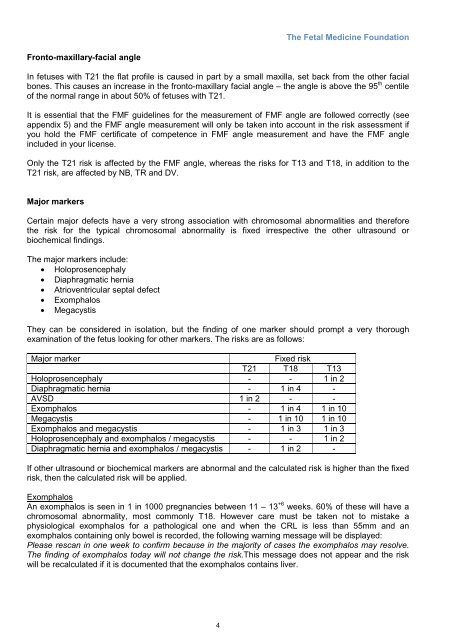Fetal Medicine Foundation First Trimester Screening
Fetal Medicine Foundation First Trimester Screening
Fetal Medicine Foundation First Trimester Screening
Create successful ePaper yourself
Turn your PDF publications into a flip-book with our unique Google optimized e-Paper software.
The <strong>Fetal</strong> <strong>Medicine</strong> <strong>Foundation</strong><br />
Fronto-maxillary-facial angle<br />
In fetuses with T21 the flat profile is caused in part by a small maxilla, set back from the other facial<br />
bones. This causes an increase in the fronto-maxillary facial angle – the angle is above the 95 th centile<br />
of the normal range in about 50% of fetuses with T21.<br />
It is essential that the FMF guidelines for the measurement of FMF angle are followed correctly (see<br />
appendix 5) and the FMF angle measurement will only be taken into account in the risk assessment if<br />
you hold the FMF certificate of competence in FMF angle measurement and have the FMF angle<br />
included in your license.<br />
Only the T21 risk is affected by the FMF angle, whereas the risks for T13 and T18, in addition to the<br />
T21 risk, are affected by NB, TR and DV.<br />
Major markers<br />
Certain major defects have a very strong association with chromosomal abnormalities and therefore<br />
the risk for the typical chromosomal abnormality is fixed irrespective the other ultrasound or<br />
biochemical findings.<br />
The major markers include:<br />
• Holoprosencephaly<br />
• Diaphragmatic hernia<br />
• Atrioventricular septal defect<br />
• Exomphalos<br />
• Megacystis<br />
They can be considered in isolation, but the finding of one marker should prompt a very thorough<br />
examination of the fetus looking for other markers. The risks are as follows:<br />
Major marker<br />
Fixed risk<br />
T21 T18 T13<br />
Holoprosencephaly - - 1 in 2<br />
Diaphragmatic hernia - 1 in 4 -<br />
AVSD 1 in 2 - -<br />
Exomphalos - 1 in 4 1 in 10<br />
Megacystis - 1 in 10 1 in 10<br />
Exomphalos and megacystis - 1 in 3 1 in 3<br />
Holoprosencephaly and exomphalos / megacystis - - 1 in 2<br />
Diaphragmatic hernia and exomphalos / megacystis - 1 in 2 -<br />
If other ultrasound or biochemical markers are abnormal and the calculated risk is higher than the fixed<br />
risk, then the calculated risk will be applied.<br />
Exomphalos<br />
An exomphalos is seen in 1 in 1000 pregnancies between 11 – 13 +6 weeks. 60% of these will have a<br />
chromosomal abnormality, most commonly T18. However care must be taken not to mistake a<br />
physiological exomphalos for a pathological one and when the CRL is less than 55mm and an<br />
exomphalos containing only bowel is recorded, the following warning message will be displayed:<br />
Please rescan in one week to confirm because in the majority of cases the exomphalos may resolve.<br />
The finding of exomphalos today will not change the risk.This message does not appear and the risk<br />
will be recalculated if it is documented that the exomphalos contains liver.<br />
4
















